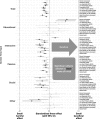Type of screen time moderates effects on outcomes in 4013 children: evidence from the Longitudinal Study of Australian Children
- PMID: 31783878
- PMCID: PMC6884886
- DOI: 10.1186/s12966-019-0881-7
Type of screen time moderates effects on outcomes in 4013 children: evidence from the Longitudinal Study of Australian Children
Abstract
Background: Excessive engagement with digital screens is harmful to children's health. However, new evidence suggests that exposure at moderate levels may not be harmful and may even provide benefit. Therefore, our objective was to determine if there are curvilinear relationships between different types of screen time and a diverse set of outcomes, including health and education.
Methods: We address our objective using a repeated measures design. Children (N = 4013), initially aged 10-11 were assessed every 2 years between 2010 and 2014. Children's screen time behavior was measured using time-use diaries, and categorized into five types: social, passive, interactive, educational, or other. We used measures of children's physical health, health-related quality of life, socio-emotional outcomes, and school achievement. The analysis plan was pre-registered. Models were adjusted for gender, socio-economic status, ethnicity, number of siblings, and housing factors.
Results: There were linear associations between total screen time and all outcomes, such that more screen time was associated with worse outcomes. However, there was variability when examined by screen time type. Passive screen time (e.g., TV) was associated with worse outcomes, educational screen time (e.g., computer for homework) was associated with positive educational outcomes and had no negative relations with other outcomes. Interactive screen time (e.g., video games) had positive associations with educational outcomes but negative associations with other outcomes. In all instances, these significant associations were small or very small, with standardised effects < 0.07. We found little evidence of curvilinear relationships.
Conclusions: The small effects of screen time on children's outcomes appear to be moderated by the type of screen time. Policy makers, educators, and parents should consider the type of screen time when considering the benefits and harms of use.
Keywords: Children; Education; Health; Screen time.
Conflict of interest statement
The authors declare that they have no competing interests.
Figures
Similar articles
-
Does home equipment contribute to socioeconomic gradients in Australian children's physical activity, sedentary time and screen time?BMC Public Health. 2016 Aug 5;16:736. doi: 10.1186/s12889-016-3419-9. BMC Public Health. 2016. PMID: 27496020 Free PMC article.
-
Joint physical-activity/screen-time trajectories during early childhood: socio-demographic predictors and consequences on health-related quality-of-life and socio-emotional outcomes.Int J Behav Nutr Phys Act. 2019 Jul 8;16(1):55. doi: 10.1186/s12966-019-0816-3. Int J Behav Nutr Phys Act. 2019. PMID: 31286983 Free PMC article.
-
The mediating role of the home environment in relation to parental educational level and preschool children's screen time: a cross-sectional study.BMC Public Health. 2017 Sep 2;17(1):688. doi: 10.1186/s12889-017-4694-9. BMC Public Health. 2017. PMID: 28865436 Free PMC article.
-
A Reflection on Controversial Literature on Screen Time and Educational Apps Use in 0-5 Years Old Children.Int J Environ Res Public Health. 2020 Jun 28;17(13):4641. doi: 10.3390/ijerph17134641. Int J Environ Res Public Health. 2020. PMID: 32605168 Free PMC article. Review.
-
Effects of screentime on the health and well-being of children and adolescents: a systematic review of reviews.BMJ Open. 2019 Jan 3;9(1):e023191. doi: 10.1136/bmjopen-2018-023191. BMJ Open. 2019. PMID: 30606703 Free PMC article.
Cited by
-
A Longitudinal Study of the Relation between Childhood Activities and Psychosocial Adjustment in Early Adolescence.Int J Environ Res Public Health. 2021 May 16;18(10):5299. doi: 10.3390/ijerph18105299. Int J Environ Res Public Health. 2021. PMID: 34065751 Free PMC article.
-
An umbrella review of the benefits and risks associated with youths' interactions with electronic screens.Nat Hum Behav. 2024 Jan;8(1):82-99. doi: 10.1038/s41562-023-01712-8. Epub 2023 Nov 13. Nat Hum Behav. 2024. PMID: 37957284
-
Behavioral Strengths and Difficulties and Their Associations with Academic Performance in Math among Rural Youth in China.Healthcare (Basel). 2022 Aug 28;10(9):1642. doi: 10.3390/healthcare10091642. Healthcare (Basel). 2022. PMID: 36141254 Free PMC article.
-
Effectiveness and moderators of a multicomponent school-based intervention on screen time devices: the Movimente cluster-randomized controlled trial.BMC Public Health. 2021 Oct 13;21(1):1852. doi: 10.1186/s12889-021-11895-2. BMC Public Health. 2021. PMID: 34645402 Free PMC article. Clinical Trial.
-
A systematic review of screen-time literature to inform educational policy and practice during COVID-19.Int J Educ Res Open. 2021;2:100094. doi: 10.1016/j.ijedro.2021.100094. Epub 2021 Nov 9. Int J Educ Res Open. 2021. PMID: 35059672 Free PMC article. Review.
References
-
- Council on Communications and Media. Media use in school-aged children and adolescents. Pediatrics. 2016;138. Available from: 10.1542/peds.2016-2592. - PubMed
-
- Department of Health. Australia’s Physical Activity and Sedentary Behaviour Guidelines: Department of Health; 2014. Available from: http://www.health.gov.au/internet/main/publishing.nsf/content/health-pub... Accessed 10 May 2019
-
- Liu Mingli, Wu Lang, Yao Shuqiao. Dose–response association of screen time-based sedentary behaviour in children and adolescents and depression: a meta-analysis of observational studies. British Journal of Sports Medicine. 2015;50(20):1252–1258. doi: 10.1136/bjsports-2015-095084. - DOI - PMC - PubMed
-
- Tremblay Mark S, LeBlanc Allana G, Kho Michelle E, Saunders Travis J, Larouche Richard, Colley Rachel C, Goldfield Gary, Gorber Sarah. Systematic review of sedentary behaviour and health indicators in school-aged children and youth. International Journal of Behavioral Nutrition and Physical Activity. 2011;8(1):98. doi: 10.1186/1479-5868-8-98. - DOI - PMC - PubMed
MeSH terms
LinkOut - more resources
Full Text Sources



